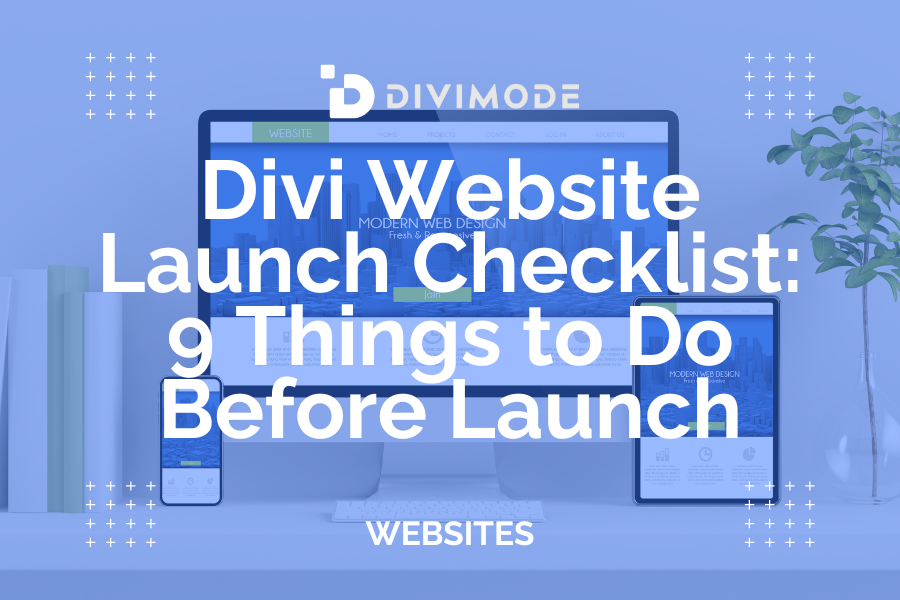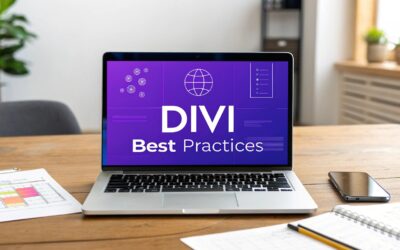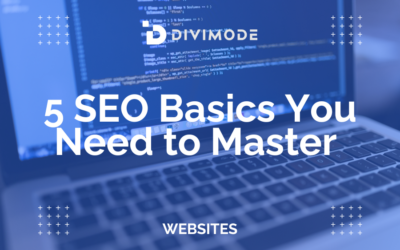So, you’ve finally done it, congratulations! Your new Divi website is nearly finished, so you’re excited about what you’ve been working on for months. Things are exciting!
However, there are plenty of things that can go wrong with launching a new website. From broken links, non-correct site redirects, to non-compatible plugins, you name it.
Thus, instead of worrying about the what ifs, wouldn’t it be much easier to have a comprehensive website checklist to run down before every site launch?
Luckily, we’ve created this Divi website launch checklist just for you. Continue reading to learn what actions you should take before successfully launching your new website.
Table of Contents
- 1.Examine Your Previous Website – If You Have One
- 2. Examine the Technicals
- 3. Conduct a Design and Layout Audit
- 4. Examine Your Content
- 5. Ensure That Your Website Is Accessible
- 6. Speed Up the Website
- 7. Ensure a Mobile-Friendly Design
- 8. Have an SEO Strategy
- 9. Maintain Legal Compliance
- 10. Prepare a Marketing Plan
- Wrapping Up
1.Examine Your Previous Website – If You Have One

Are you about to launch a brand-new website with Divi, or are we talking about a redesign where you’re about to use the theme? If you’re about to do an entire redesign of your Divi website, there are several steps that you should take.
Review the Site’s Structure
Restructuring your entire website might feel like a chore at the beginning. But this task is a must, or otherwise, the navigation would be a mess for both Google and the target users. To prevent that from happening:
- Focus on your menu: When you plan to restructure things, consider whether you can fit all the important pages in the main menu. Are there some pages that are not valid anymore?
- Revise the taxonomy: Is there one category or subcategory that is more successful than the rest? Think about whether you can split a complex category into multiple subcategories or merge more subcategories into one important category.
- Tidy up obsolete content: Are there some outdated blog posts you wish to unpublish or perhaps repurpose and publish again? If that’s the case, you might want to get rid of them entirely.
- Avoid keyword cannibalization: Optimizing for keywords that are too similar can produce negative results for your SERP ranking, and not to even mention that you’ll be competing with yourself instead of with other businesses online.
Set SMART Goals
How you’ll attain your website’s goals? What metrics will be measured to help you achieve those goals successfully?
Whatever the future goals are, you need to outline precisely how the new website will help you achieve them and implement the changes accordingly.
Setting website design goals can help you create stronger content, organize your website better, and measure the design’s effectiveness.
Goals can differ from website to website. However, the best goals are defined according to the SMART methodology:
- S – Specific: ‘Increasing product sign-ups’ is not as specific as ‘Increasing product sign-ups by 30% in the next 4 months’. Specificity helps you figure out more effective ways about how you’ll achieve and measure the goals.
- M – Measurable: You’ll only know if you’ve achieved any progress with your goals if you measure them. Define how many times you want the goal to be achieved, the stages in which it will be achieved, as well as the key metrics that you’ll track over a given period.
- A – Attainable: When a goal is not realistic or attainable, you’re pretty much wasting the team’s time on something that might not arrive soon. Break down a massive goal into more manageable parts and start from there.
- R – Relevant: Your homepage won’t have the same goals as one of your landing pages. Make sure that you’ll match the goals according to what your business and products are about.
- T – Time-Based: A goal without a specific timeframe can’t be measured accurately. ‘Improving sales of product X by 25% over the next 4 months’ is how a time-based goal should sound like.
2. Examine the Technicals

The technical aspects of your new Divi website go together with the site’s overall functionality and compatibility. That is why you need to ensure everything in the background performs as intended.
Validate the Code
Granted, code validation should be done throughout the development stages, but it’s a good rule of thumb to validate once more before you launch the website.
By using a code validator, you can spot issues on your website, such as a misplaced piece of code or a forgotten element that you need to rework to appear much better on your website.
The following is only a quick list of tools to help you validate your code before launch: W3C’s HTML Validator, W3C’s Validators Collection, W3.org’s CSS Validator.
Test Site links
Make sure that the entire link structure is stable. Each broken link has the potential to hurt your site’s UX and performance, and you need to eradicate broken links immediately once discovered.
At this point, you might ask yourself – Well, how can I check if there are broken links on my Divi website?
Checking each link manually can take too much of your time, particularly if you need to scan your links every time you update your website. To save you the trouble with this step, there are several tools that can do the job for you:
- WordPress Broken Link Checker: This plugin leaves no stone unturned. Whenever a broken link is detected, the plugin will send you a notification. Then, you can decide if you want to edit the broken link, update it, or delete it from your page.
- Google Search Console: Google Search Console allows you to use many beneficial features for your SEO strategy, including site crawling and reporting 404 errors on your links. Then, all you must do is correct the broken links and improve your SERP rankings as a result.
- Ahrefs Site Audit Tool: This tool can automatically scan your Divi website for errors. All you have to do is set up an account and enter your site’s URL in the tool. Ahrefs will deliver a 404 errors report, indicating where and which links you need to fix.
Set up Google Analytics
Once you publish your website, your number one goal should be to get more traction, traffic, and ultimately, new subscribers and customers as a result.
Website analytics help you gauge how many visitors your website gets, what type of content visitors like, where users come from, and much more. Integrating Google Analytics allows you to see:
- Who visits your website: GA helps you uncover users’ geo-locations, the browsers they used to access your website, and other important information such as the screen, devices, and JavaScript support through which users open your site.
- What users do on your website: GA enables you to discover where users go as soon as they open one of your pages, how much time do they spend on your site, and the bounce rate for every page, information that you can use to make an informed decision on what you need to do to decrease your bounce rate.
- When users visit your website: Looking at the hours at which users visit your website the most, you can gauge when the best time is to publish your new blog posts and interact with potential customers that are online at that time.
- How users find your website: GA’s referral sources overview walks you through the places that you need to focus on the most to get traffic. For example, suppose you get most of your traffic via LinkedIn. In that case, you need to have a detailed and dedicated LinkedIn content strategy to interact with your target audience there continuously.
- How users interact with your content: GA informs you how users interact with the content by presenting you with a percentage of users that have clicked on your pages, so you can focus your strategies on a particular type of content and avoid the tactics that don’t work.
Integrating GA within WordPress is fairly simple, especially with a detailed tutorial at hand (for novice users).
Strengthen the Security
Safeguarding your Divi website is one of the best ways to make sure you’re your business and users that visit your new site are safe. There are several aspects to keep in mind when securing your Divi website:
- Updates: You must keep the entire WordPress core, Divi theme, and plugins updated. There shouldn’t exist any hole or weakness that a hacker can use to access your code.
- Passwords: Never use simple passwords for your Divi website. A password ‘1234567891011’ is as good as not having a password at all. If you’re using multiple passwords, make sure that you keep each password in a secure place restricted from unauthorized users.
- Logins: Make sure that you don’t allow easy access to the login screen of your website. Don’t allow hackers and bots a chance to guess your password and try to enter your site through a brute-force attack and use a plugin that blocks these attempts.
- User Roles: Each user role and permission must be based according to preferences and required (or designated) access. Set the roles according to needs and restrict access to everything else.
- Backups: Make sure that you’ll have backups of your website on a secure server. Whatever goes wrong in the future, you need to ensure that everything will be back in place as it used to be, from theme customizations to plugins and content settings.
- Firewalls and SSL: A Web Application Firewall (WAF) forms a wall between networks to filtrate network traffic. The Secure Sockets Layer (SSL) encrypts links between browsers and servers.
- Security Plugins: A quality security plugin can enable you to scan your Divi site for malware and block suspicious IPs and users.
Make sure that you’re following the best WordPress security practices and that you’ll use the right plugins before you go live.
Update WordPress and Plugins
Using WordPress as the top CMS in the marketplace already simplifies your work in multiple ways, such as providing you with countless tools and options to develop, update, and manage your brand online, even without a detailed technical knowledge.
But still, like any other CMS, WordPress needs to be updated regularly if you want to ensure that your Divi website remains stable and that you can benefit from the latest features. Luckily, the CMS provides users with regular updates that enhance the platforms’ features.
Therefore, before launching your Divi website, check if you’ll be using the latest WordPress version and if everything is compatible.
Test Browser Compatibility
While all browsers seem alike, they all have different code and handle web elements differently, which is why you need to make sure that your Divi website is compatible with every major browser before you publish it.
Seeing it how it looks from your browser is not sufficient to get a sense of how it will appear on different browsers such as Chrome, Firefox, Opera, and Safari. A great tool to help you with this purpose is Browsershots. W3’s latest browser stats reveal exactly which browsers you need to focus on. Throughout the testing process, you need to ensure that the layouts, fonts, navigation, and other elements of your site’s design are displayed properly on each of the browsers.
3. Conduct a Design and Layout Audit

When designing a website from scratch, it’s easy to miss something between the iterations that you go through. The new design should welcome users and make them stay there.
Since we already know that nowadays people’s attention span is short, and the expectations are high, you need to pay particular attention whether the design is attractive and simple enough to retain users and keep them engaged.
When auditing the design of your Divi website, use the following checklist:
- Make sure that the pages are structured for easy understanding. Everything from the header to the footer should help the user navigate better on the page. When applicable, use breadcrumbs and links in your footer to help users navigate even better.
- Ensure that the density of your content doesn’t drive away visitors from your site. You’re your content properly with headers, media, and the right amount of white space.
- Make sure that your website renders great on every device, whether that’s a desktop PC, laptop, smartphone, or tablet.
- Ensure that the visual elements and background illustrations share the branding style and create a smooth transition between sections of the page.
Examine the Branding Elements
To figure out the design of your website, you need to examine how the visual and branding elements are connected, and if there’s any discordance between them. For example, as a business, your logo, content, and visual elements such as images need to share the same branding style and consistency.
The following steps should help you ensure that your website’s visuals strike home:
- Check if the logo is consistent across all pages.
- Ensure that the background images are styled similarly.
- Ensure that icons are styled similarly, and if not, replace them with a single family alternative such as the Font Awesome Icons, that is compatible with Divi).
4. Examine Your Content

Content is one of the key aspects that separates your website from the rest. That’s why before your launch your new website, you need to ensure that your content is relevant and on point. After each content audit, you need to uncover:
- Methods for improving organic SERP rankings
- The content pieces that have performed the best
- Topics that your audience prefers to learn about
- Content gaps that you can fill to build up your sales funnel
- Discover pages with a low conversion rate, but a high number of visits
- Eliminate content that is no longer relevant for your business
Ensure that your content is free of grammatical, spelling, and factual blunders, and keep the content formatting coherent across all pages.
For this purpose, you can use tools such as Hemingway and Grammarly. If you focus on content-first design, you’ll want to focus on finetuning the work for your readers.
5. Ensure That Your Website Is Accessible

Your website won’t be only about style and content. You must also provide accessibility and great UX to all users. Accordingly, you must also make your website easy to interact with and navigate for everyone, including people with disabilities.
Here’s what you can do to ensure that your Divi website is more accessible before launching it:
- Study the W3C, WAI, and WCAG guidelines carefully.
- Install a WordPress accessibility plugin to detect accessibility issues.
- Ensure that your code is accessible to site visitors with screen-reading technology.
- Implement fonts and colors that don’t hinder the content’s readability.
- Create well-ordered and clearly written content.
- Test the website’s accessibility regularly.
Make sure that users can navigate on site with the keyboard, all your image files contain an alt text, headers are formatted correctly, and that your forms work as they should.
To test the accessibility of your website, consider the following tools: WAVE , Tenon, Google Lighthouse, SiteImprove.
6. Speed Up the Website

So, the design is ready, the content is of high-value, and the structure and UX are on point. But you’re not ready to launch yet. Not until you test drive and examine the website’s performance.
Speed and efficiency can make or break your website. According to Google, you have about two seconds or less for your website to load. If the loading time takes longer than that, it’s likely that users will start to lose interest about your website.
Moreover, page speed is a significant ranking factor used by ranking factor used by Google and other search engines alike. The quicker your Divi site is, the greater the chances are to get better spot at SERPs.
Conducting tests will enable you to solve any potential performance issue much easily, and the future optimization process will become more straightforward as a result.
You can test your website’s performance with at least one of the following tools:
However, testing is not enough, WordPress combined with Divi doesn’t exactly translate into a fast website as default.
You need to take certain steps to ensure that your loading speed is under 2-3 seconds:
- Run regular performance tests.
- User a reliable hosting provider.
- Update your theme and plugins.
- Delete obsolete and unused plugins.
- Optimize images, reduce CSS and JavaScript.
- Install a powerful WordPress caching plugin.
- Clen up the website’s database.
- Use a Content Delivery Network (CDN).
7. Ensure a Mobile-Friendly Design

Since 2016, Google announced that they’ll gradually progress towards mobile-first website rankings, which entails checking the website’s mobile version first, ahead of the desktop one.
It’s a mobile-first world, and moreover, search engines consider mobile friendliness as a ranking factor, which means that mobile-responsive will always rank higher than non-responsive pages.
Your Divi website may come as mobile-responsive by default. But still, you can do so much more to optimize your new website for smartphones before the launch:
- Optimize Images: To ensure that your Divi website is mobile-friendly, you need to optimize image sizes for mobile with tools such as TinyPNG or WPSmush.
- Use Google’s AMP: Accelerated Mobile Pages is Google’s open-source project that provides faster-loading content for mobile devices. It helps you create mobile-friendly content that is readily available on Google search and social media pages.
- Test Mobile-Friendliness: Type the URL on your smartphone, and check if the navigation and the interactions with all the other elements is straightforward. There are plenty of tools available to check mobile-friendly design, including Google’s Mobile-Friendly Test, W3C Mobile OK Checker, and MobiReady.
For more information on how to achieve mobile-friendly website design that will adhere to Google’s mobile-first indexing, please read the following official guides: Mobile-Friendly Websites & Mobile Usability Report.
8. Have an SEO Strategy

Having an SEO strategy matters mostly because it can help you stay accountable when creating your content, and make sure that you create what your target readers are searching for.
If your content is disorganized, search engines will have great difficult time in indexing your website and identifying your expertise.
To set your Divi website for SEO success before launch, ensure that you’ll go through the following checklist:
- Examine your website carefully for duplicate issues. Regardless of how severe the duplicate issue is, your website might suffer from lower rankings.
- Don’t duplicate meta descriptions. When a given content is found on various URLs of your site, it must be canonicalized for Google, which is done via the rel=canonical attribute or a 301 redirect.
- Make sure that each of your URLs are search-engine-friendly. Examine the site and check if your URLs have a clear structure.
- Install an SEO plugin. SEO plugins come in handy when optimizing your site for search engines, and there are many beneficial plugins that can help your efforts, including Yoast SEO and SEO Press.
- Map out each keyword.This makes the future SEO activities more straightforward and ensures that your top pages target the right keywords.
- Fix broken links. Before you launch your Divi website, you need to check if there are any broken links that you’ve missed. Fixing broken links helps you improve the UX of your site and improve search rankings in the process.
- Add schema markup. That will let search engines know what your content is about and will help them present the content in SERPs in a much more user-friendly manner.
- Improve the UX. Google puts user experience as a key ranking factor, and thus, it makes complete sense to focus on delivering better UX with your new website.
There are several excellent online tools available that can help you examine each technicality of your SEO efforts:
By completing the SEO checklist above, you’ll enable search engines to crawl your Divi website successfully and that you’ll have excellent chances to rank on SERPs.
9. Maintain Legal Compliance

Within every industry, there are rules, laws, and regulations that you must respect and follow. Thus, it’s more important than ever to ensure a complete legal compliance and respect consumers and the area that you operate in. Focus on the following:
- Have a ‘Terms of Service’ page in place that outlines your services, as well as your privacy policy in greater detail.
- Ensure that you make a cookie notification to your potential and current customers.
- Make sure that you own license for every tool and media that you use on your Divi website.
If you’re selling to customers from the EU, you must also take steps to comply with EU regulations like GDPR.
For further information regarding the legal compliance of your website, it’s best if you consult with a legal counsel and ensure that you won’t miss a single aspect.
As an addition to the information above, we recommend that you read some of our recent articles on must-have legal pages for your Divi website, as well as GDPR and CCPA related topics:
- 4 Must-Have Legal Pages on Your Divi Website
- The 4 Best WordPress GDPR Compliance Plugins
- You’re Welcome: 7 Key CCPA Compliance Tips
- CCPA Compliance for Divi Websites: What are The Rules
- Divi GDPR Compliance: How to Do It Smartly
10. Prepare a Marketing Plan

In the end, when you’ve passed through all of the steps above successfully, you need to promote your Divi website!
After all, you’ll have thousands of websites as your competitors, and it is pivotal to create a buzz about your business online.
The following are the most important website promotion methods to prepare for:
- SEO: If your SEO is on point and you’ve written authoritative content pieces about the niche you’re working in, you’ll be able to rank for the most important search queries and keywords.
- Paid Ads: When done right, paid advertising can be an excellent source of targeted traffic and qualified leads for your Divi website.
- Email Marketing: Build your database of potential customers to send them out a regular newsletter after you launch your website.
- Social Media: Announce that you have a new Divi website on social media channels. Go live after launching to tell your followers what’s new. Promote pages and content regularly.
By preparing your marketing efforts in advance, you’ll be able to immediately increase the brand awareness and the targeted traffic to your website, resulting in a boost of new customers for your business.
Wrapping Up
When you’re launching your new Divi website, there are lots of aspects that you need to think about. Even if you’re expert at launching websites, you can’t be 100% confident that you haven’t forgotten something.
We hope that by the end of reading this article, you’ll be ready is to launch your new website, and that all that’s left is to earn your customers’ trust and grow your business. Good luck!

Try Divi Areas Pro today
Sounds interesting? Learn more about Divi Areas Pro and download your copy now!
Many pre-designed layouts. Automated triggers. No coding.
Click here for more details






